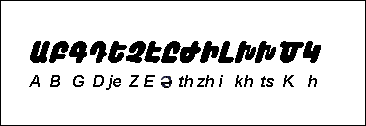 Because
of the presence of many words borrowed in ancient times from Iranian, Armenian
was long believed to be an Iranian dialect. Nowadays it is spoken by Armenians
in Turkey and the Republic of Armenia, and in Armenian settlements elsewhere
in the Middle East, Europe, and the United States. Modern scholarship has
firmly established it as an independent branch of the Indo-European language
family, but further Phrygian was added
to this group.
Because
of the presence of many words borrowed in ancient times from Iranian, Armenian
was long believed to be an Iranian dialect. Nowadays it is spoken by Armenians
in Turkey and the Republic of Armenia, and in Armenian settlements elsewhere
in the Middle East, Europe, and the United States. Modern scholarship has
firmly established it as an independent branch of the Indo-European language
family, but further Phrygian was added
to this group.
Armenian is known to have replaced the earlier languages of the historical Armenian region by at least the 7th century BC, and it may have been influenced by the languages it replaced. In 410 AD, according to tradition, Armenian acquired an alphabet invented by St. Mesrob, a monk and scholar. A literature appeared by the 5th century, and the written language of that era, called Grabar or Classical Armenian, with various changes remained the literary language until the 19th century. Meanwhile, the spoken language developed independently; many dialects appeared, not all mutually intelligible. A nationalist movement in the 19th century led to the creation of two slightly different modern literary dialects that are closer to the spoken language: Eastern or Yerevan Armenian (the official language of the Armenian republic) and Western or Turkish Armenian. The differences in the two dialects are simple. The Armenian alphabet has 2 r's, 3 ch's, 3 t's, and 2 p's. In western Armenian, some of the distinctions between the relative soft d and the middle t have disappeared, for instance, whereas in eastern Armenian the sounds are distinct. A western Armenian speaker can hear the differences, but is not used to them so they have melted away and are assigned as funny spellings using two different t's in the same word. The other difference is the conjugation of verbs. The present tense in western Armenian looks like the future tense in eastern Armenian. The marker for the future tense in western Armenian elicits strange looks from eastern Armenian speakers. The present tense in eastern Armenian has the same root word, but is formed differently.
Armenian has many harsh combinations of consonants and is particularly
rich in affricative sounds (such as f, h, th). Both Classical
Armenian and the modern spoken and literary dialects have a complicated
system of noun declension, with six or seven cases (but no grammatical
gender). The old verb inflections in general have been replaced by modern
forms that require auxiliary verbs (comparable to English "he will go"),
and negative verbs are conjugated differently than positive ones are. Grammatically,
early forms of Armenian had much in common with Greek, but Modern Armenian
appears, after centuries of geographical proximity, to have absorbed some
grammatical influences from Turkish (for instance, postpositions instead
of prepositions).